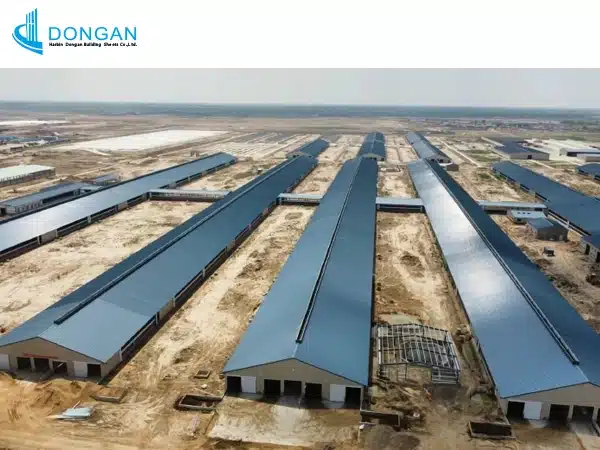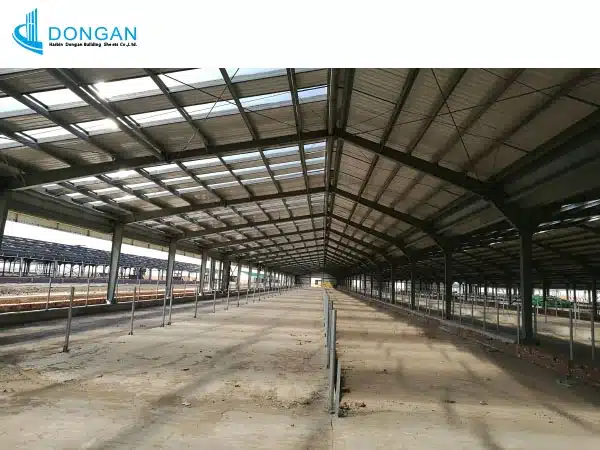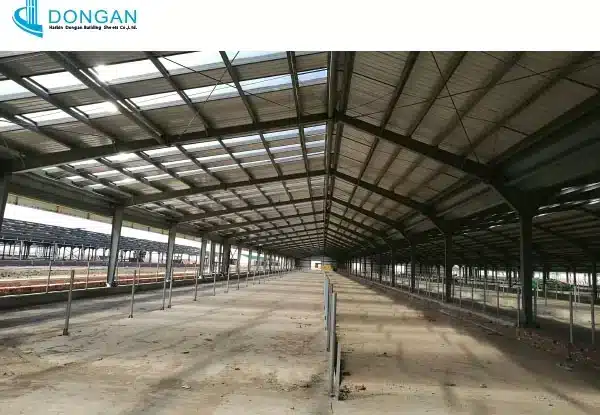In modern construction, the applications of steel structures cannot be overemphasized. Steel is much valued for its strength, flexibility, and cost-effectiveness, and is therefore favored as a material by most forms of buildings. Such a common form of steel structure is the portal steel frame. Here, we discussed the nature of portal steel frames, their benefits, and their place in the overall topic of fabricated steel structures.
What is a Portal Steel Frame?
The portal steel frame is an industrial, commercial, and agricultural building structural system. It is a connection of steel rafters and columns that are coupled with stiff joints to form arched or rectangular shapes. The portal frame has the advantage of obtaining great open areas without internal supports and is therefore appropriate for colossal structures like sports halls, factories, and warehouses.
The most characteristic feature of the portal steel frame is that it redistributes loads efficiently both vertically and horizontally. This renders it highly effective against dead loads and live loads, as well as against external loads such as wind and seismic forces. Rigidity in joint connections between the members of the frame also leads to stability and durability, which are vital for large structures.

Principal Components of a Portal Steel Frame
- Columns: Vertical members supporting the loads of the building and transferring loads from the top to the foundation.
- Rafters: Sloping or horizontal beams that span across the building width and provide support to the roof.
- Purlins: Secondary horizontal beams supporting the roof cladding.
- Bracing: The diagonal members provide the lateral stability against wind or seismic pressure.
- Attachments: Rigid connections linking the rafters and columns, to give the general stability of the frame.
All these products in steel buildings are prefabricated at a factory and then transported to the site for installation. This has the result of speeding up the building process and raising the overall quality of the building because each piece is built to precise specifications.
Benefits of Portal Steel Frames in Steel Fabricated Buildings
Using portal steel frames in steel fabricated buildings has several significant benefits, which are:
- Cost-Effectiveness: Steel frames are not expensive to manufacture and install, which means lower overall building costs. Using portal steel frames reduces the need for interior supports, simplifying the design process and using less material.
- Flexibility: The portal steel frames can provide vast open spaces, enabling them to be the perfect solution for various uses, from factories and warehouses to farm buildings and sports halls. Because there are no internal columns, the interior can be arranged to meet a specific need, offering greater design flexibility.
- Speed of Construction: Site construction time is minimal since steel members in portal steel frames are fabricated off-site. This means quicker project completion and earlier occupation, a factor that is significant for companies that need to have an early move-in.
- Strength and Durability: Steel is very strong and durable. A portal steel frame can carry heavy loads and external forces such as wind or earthquake. Steel also resists corrosion and insects, thus it’s a suitable material for buildings that can last for decades.
- Sustainability: Steel is 100% recyclable, and site waste is minimized through the use of prefabricated steel components and a cleaner construction process.
Portal Steel Frames in Fabricated Steel Structures: A Synergetic Approach
An all-around solution to the modern building construction comes in the form of integrating portal steel frames with the overall general framework of fabricated steel structures. The present structure, referred to as the fabricated steel structure, encompasses the frame along with the cladding, roofing, and foundation systems. This offers a global construction solution that maximizes both structural performance and the functional aspect of the building.
In man-made steel structures, every part operates together with others. To put this into perspective, the portal steel frame supports the roof, which might be made of steel panels, sheet metal, or other materials. The selection of roofing materials could be based on thermal insulation, climate, and aesthetics.
The steel framing can be designed to meet the specific requirements of the project, whether it is for heavy machine support, wide space, or other specialized load requirements. Portal steel framing combined with the rest of the fabricated components produces a highly versatile, flexible, and durable building system.
The Portal’s flexibility of the steel frames
One of the main reasons that portal steel frames are used is that they are extremely flexible. The frames can be utilized in any kind of application, ranging from farm barns to complex industrial facilities. The clear-span function provided by portal steel frames means that they are extremely versatile, and it is easy to add or modify the building as desired over time as the owner expands.
For instance, on a farm portal steel frame can be used to provide the large barns for storage or stock, where the open and unobstructed space is of great significance. In industry, portal frames are used in warehouses, factory plants, and distribution centers where it has to accommodate and transport massive machines.
Additionally, the aesthetic appeal of portal steel frames should not be overlooked. While they are used primarily for their functional benefit, the frames may be so designed with architectural beauty as well. Their clean, contemporary look can be an attractive feature of commercial, even residential, buildings, bringing form and function together.

The Future of Portal Steel Frames in Fabricated Steel Structures
As the construction industry continues to innovate, the use of portal steel frames will continue to grow, especially as technology advances. There is more use of computer-aided design (CAD) and Building Information Modeling (BIM), which brings more precision, effectiveness, and flexibility in steel frame designing. The software allows architects and engineers the chance to develop highly optimized structures that maximize the efficient use of materials while minimizing waste.
Additionally, the need for green buildings will still affect the application of steel buildings. Since steel is recyclable, energy-efficient, and can resist environmental changes, it is an option favored for use in green building construction.
Conclusion
The portal steel frame is a witness to the strength and versatility of industrial steel frameworks in today’s buildings. The frames are an economic, long-term, and flexible alternative to the supply of large open spaces for industrial, commercial, or agricultural use. By positioning the role of portal steel frames and their benefits within the overall context of fabricated steel structures, architects, engineers, and contractors are able to make informed decisions that maximize the usability, efficiency, and sustainability of projects.
With advanced technology and increasing demand for efficient and sustainable means of building, portal steel frames and engineered steel structures will simply increase in importance, establishing themselves as the future of modern construction and architecture.






